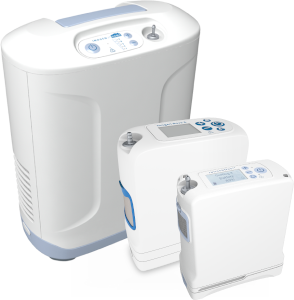 COPD is the sixth leading cause of death in the United States in 2020, yet people don’t realize that in many cases, prevention of COPD is possible. While tobacco smoke is the primary cause, 1 in 4 people with COPD have never smoked.[1] There are a number of other important risk factors that increase your chances of being diagnosed.
COPD is the sixth leading cause of death in the United States in 2020, yet people don’t realize that in many cases, prevention of COPD is possible. While tobacco smoke is the primary cause, 1 in 4 people with COPD have never smoked.[1] There are a number of other important risk factors that increase your chances of being diagnosed.
COPD Risk Factors: What Are They?
Though many people ask what causes COPD, there is not a single answer. Instead, there are a number of COPD risk factors that work together to cause this disease. If you want to know what causes COPD in nonsmokers, take a look at the following risk factors for COPD, some of which may surprise you:
Genetics
Whether you are tall or short, have blue eyes or brown, are thin or full-figured has little to do with what your parents wished for, but everything to do with genetics. However, your looks are not the only thing affected by your genes; genetics also play an important role in the development of many chronic diseases. So, is COPD genetic? While we can’t say that COPD is entirely caused by genetics, your risk factor for developing COPD can absolutely be genetic. The most easily recognized genetic risk factor for COPD is alpha-1 antitrypsin (AAT) deficiency.
AAT deficiency is passed on to a child at birth by one, or both, parents. It is caused by lack of AAT, a protective protein made by the liver. People who have AAT deficiency are at greater risk for developing liver and/or lung disease. If you have AAT deficiency, smoking dramatically increases your chances of developing COPD. [2]
Tobacco Smoke
Tobacco smoke remains the single most important risk factor for COPD, worldwide. If you are curious about what makes COPD worse, smoking is at the top of the list. In fact, as many as 75% of all deaths from COPD are related to cigarette smoking.[1] The fact that not all smokers develop COPD tells us that the relationship between smoking and COPD death rates has a lot to do with genetics. However, the number of smokers who go on to develop COPD is steadily rising; recent reports suggest that as many as 50% of all smokers are diagnosed.[3] Moreover, smoking during pregnancy is known to affect fetal growth and development and is thought to lead to increased COPD risk and the development of lung disease later in life.[4] Prevention of COPD starts with avoiding smoking altogether.[1]
Occupational Exposure
When it comes to what causes COPD, occupational exposure is another of the top COPD risk factors. It is estimated that in the United States alone, workplace exposure to dust, chemicals, vapors and fumes is attributed to 19.2% of COPD cases in smokers and 31.1% in never-smokers. These risks are assumed to be even greater in countries with less stringent work laws.[5]
Indoor and Outdoor Air Pollution[6]
Indoor and outdoor air pollution can put you at risk. Health risks from air pollution are greatest among populations that are considered vulnerable, such as the elderly, children and those with chronic health conditions like asthma and COPD.
Common indoor air pollutants such as pollen, pet dander, particles from dust mites and cockroaches can cause allergies and trigger asthma attacks. Second-hand smoke is a known risk factor for COPD and other lung diseases. Other indoor pollutants include environmental tobacco smoke, carbon monoxide produced by fuels burned in fireplaces, furnaces, heaters and water heaters; indoor radon and asbestos. It is extremely important to take steps to improve your indoor air quality, especially if you are a COPD patient, spending a lot of your time indoors. Get rid of dust mites by washing linens frequently, keeping pets off furniture and keeping your home’s humidity level below 50 percent. Be conscious of harmful household chemicals and choose natural products to keep you and your family safe. Having live plants in your home isn’t just for beauty but is a health benefit, and studies have found that a few houseplants can significantly reduce the air pollution in your home.[4] Air filtration units can also be used to improve the indoor air you breathe.
There is growing evidence that long-term exposure to outdoor air pollution is thought to increase the risk of developing COPD. There is also strong evidence to support that exposure to particulate matter air pollution makes COPD symptoms worse, resulting in an increased risk of death in people who have existing COPD. To date, no specific medical treatment has been proven effective against air pollution-induced COPD exacerbations. While outdoor air pollution is largely beyond your control, there are some steps that you can take to lower your risk of exposure when ozone and particulate matter air pollution levels are elevated. These include: staying indoors and avoid exertion when air quality is poor, keep your windows closed, run your air conditioner in recirculation mode, breathe through your nose instead of your mouth, and exercise outdoors in the morning when pollution levels are lower.
While we often hear more about outdoor air pollution, indoor air pollutants may be more of a problem overall. But you can do much more to control the quality of the air you breathe indoors than outside. In addition to learning about your medications and how to manage your COPD, educate yourself about the common air pollutants and take measures to reduce your exposure when possible.
AGE AND GENDER [7]
According to the CDC, age-adjusted prevalence of COPD remained unchanged from 2011 to 2020. The prevalence of COPD rose with age for both men and women throughout most of the lifespan (i.e., across most age groups).
COPD prevalence estimates were higher among women compared to men across years. COPD prevalence was highest among women aged 65–74 (10.4%) and 75–84 (9.7%) and among men aged 75–84 (11.2%). COPD prevalence was greater among women than men in all age groups except the two highest age groups (75–84 and 85 and over), for which the difference was not statistically significant.
Age-standardized COPD death rates in adults aged ≥ 45 years decreased from 1999 to 2019 overall and in men.
Differences in death rates between men and women were smaller in 2019 than in 1999.
EARLY CHILDHOOD LUNG INFECTIONS [8]
Severe lung infections in early childhood have been associated with decreased lung function and the development of COPD in later life. Furthermore, low birth weight may predispose a child to lung infections, which may also increase the risk of COPD.
ASTHMA
Although more research is needed to confirm a relationship between asthma and COPD, one study found that, after adjusting for smoking, adults with asthma were 12.5 times more likely to develop COPD than adults who didn’t have asthma. [9] If you have asthma, it could be helpful to consider that it may well be among the COPD risk factors.
SOCIOECONOMIC FACTORS [10]
Several studies have confirmed the people living below the poverty line had a 1.4-time higher risk of COPD development compared with those living above the poverty line. COPD patients living in poverty are at increased risk of disease progression, acute exacerbations, and death because they are less able to access hospital services because of the cost.
If you’re interested in what causes COPD, it is a good idea to be aware of the COPD risk factors, as well as understanding that it may be a combination of factors that ultimately leads to the development of COPD. Some people may wonder, “Is COPD contagious?” but the fact is that it is a combination of genetic predisposition and environmental factors that causes COPD. Be aware of your family history, do not smoke and avoid other COPD risk factors whenever possible to minimize your likelihood of getting COPD. If you currently smoke, quit as soon as possible, as smoking is the leading cause of COPD and COPD related deaths.
COPD SCREENING TOOL
If you have symptoms of COPD, such as shortness of breath, cough and sputum production, and a history of exposure to risk factors, please take a moment to participate in this 5 Question COPD Risk Screen brought to you by the COPD foundation. Be sure to print out your results and take them to your doctor.
How Inogen Can Help
Knowing your COPD risk factors and understanding what causes COPD are extremely helpful in avoiding the disease, but COPD is a progressive disease that gets worse over time. It is treatable; with proper management, most people with COPD can achieve good symptom control and quality of life, as well as reduced risk of other associated conditions. [11] Inogen can help.
If you or a loved one has COPD, oxygen therapy can help you breathe easier and alleviate some of your symptoms.[12] Our Inogen One oxygen concentrator’s are lightweight, easy-to-use and designed to go where you go. Our Inogen One System helps provide oxygen therapy for use at home or away. Our small concentrators provide travel portability for a patient’s active lifestyle and purify air continuously from the atmosphere, providing oxygen-rich air without the need for refills or unwieldy oxygen tanks. The Inogen One is powered with a rechargeable battery or any acceptable AC or DC source; it uses a maximum of 60W of power at the highest setting. It is also one of the quieter oxygen devices available. Our portable oxygen concentrator systems are designed for your on-the-go lifestyle.
If you’re experiencing COPD symptoms, talk to your doctor about how oxygen therapy with the Inogen One can help you. Discover how Inogen can help you treat your COPD symptoms while you continue your on the go lifestyle.
References
- https://www.cdc.gov/dotw/copd/index.html. Last Reviewed: October 7, 2022
- COPD – Alpha-1 Antitrypsin Deficiency | NHLBI, NIH
- https://erj.ersjournals.com/content/erj/28/4/883.full.pdf
- https://www.ncbi.nlm.nih.gov/pmc/articles/PMC3521336/
- Syamlal G, Doney B, Hendricks S, Mazurek JM. Chronic Obstructive Pulmonary Disease and U.S. Workers: Prevalence, Trends, and Attributable Cases Associated With Work. Am J Prev Med. 2021 Sep;61(3):e127-e137. doi: 10.1016/j.amepre.2021.04.011. Erratum in: Am J Prev Med. 2022 Jul;63(1):149. PMID: 34419236; PMCID: PMC8672326.
- The Effects of Pollution on COPD: Indoor and Outdoor (verywellhealth.com)
- Products – Data Briefs – Number 63, June 2011 (cdc.gov)
- Stocks J, Sonnappa S. Early life influences on the development of chronic obstructive pulmonary disease. Ther Adv Respir Dis. 2013 Jun;7(3):161-73. doi: 10.1177/1753465813479428. Epub 2013 Feb 25. PMID: 23439689; PMCID: PMC4107852.
- Silva GE, Sherrill DL, Guerra S, Barbee RA. Asthma as a risk factor for COPD in a longitudinal study. Chest. 2004 Jul;126(1):59-65.
- The association between living below the relative poverty line and the prevalence of chronic obstructive pulmonary disease – PMC (nih.gov); Lee YS, Oh JY, Min KH, Lee SY, Kang KH, Shim JJ. The association between living below the relative poverty line and the prevalence of chronic obstructive pulmonary disease. J Thorac Dis. 2019 Feb;11(2):427-437. doi: 10.21037/jtd.2019.01.40. PMID: 30962986; PMCID: PMC6409249.
- COPD – Symptoms and causes – Mayo Clinic
- Supplemental Oxygen Therapy: Types, Benefits & Complications (clevelandclinic.org) https://my.clevelandclinic.org/health/treatments/23194-oxygen-therapy
Additional Sources
- Burden of chronic obstructive pulmonary disease and its attributable risk factors in 204 countries and territories, 1990-2019: results from the Global Burden of Disease Study 2019 | The BMJ
- COPD Trends Brief – Mortality | American Lung Association
- Cote, C.G., Chapman, K.R. Diagnosis and treatment considerations for women with COPD. March, 2009.
- Smoking’s Impact on Women’s Health | Smokefree
- https://www.copdfoundation.org/Screener.aspx
Image Credit: Flickr, Senior Couple in Swimming Pool, moodboard.







